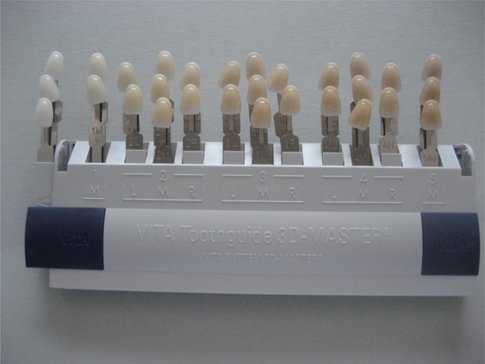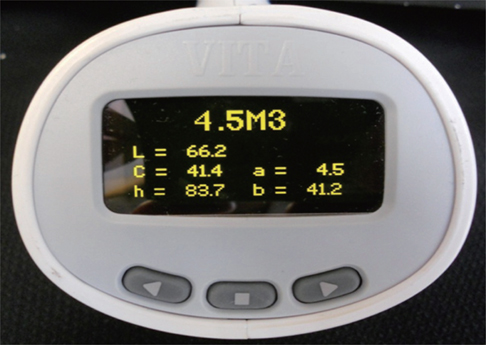J Adv Prosthodont.
2015 Dec;7(6):413-422. 10.4047/jap.2015.7.6.413.
Study of the most frequent natural tooth colors in the Spanish population using spectrophotometry
- Affiliations
-
- 1Departament of Dentistry, School of Medicine, University of Salamanca, Spain. crisgodent@usal.es
- 2Departament of Orofacial Prosthesis, Faculty of Dentistry, University Complutense of Madrid, Spain.
- KMID: 2176615
- DOI: http://doi.org/10.4047/jap.2015.7.6.413
Abstract
- PURPOSE
To identify the most frequent natural tooth colors using the Easyshade Compact (Vita -Zahnfabrik) spectrophotometer on a sample of the Spanish population according to the 3D Master System.
MATERIALS AND METHODS
The middle third of the facial surface of natural maxillary central incisors was measured with an Easyshade Compact spectrophotometer (Vita Zahnfabrik) in 1361 Caucasian Spanish participants aged between 16 and 89 years. Natural tooth color was recorded using the 3D Master System nomenclature. The program used for the present descriptive statistical analysis of the results was SAS 9.1.3.
RESULTS
The results show that the most frequent dental color in the total sample studied is 3M1 (7.05%), followed by the intermediate shade 1M1.5 (6.91%) and 2L1.5 (6.02%).
CONCLUSION
According to the research methodology used, and taking into account the limitations of this study, it can be proposed that the most frequent color among the Spanish population is 3M1; the most common lightness group is 2; the most frequent hue group according to the 3D Master System is M and the most frequent chroma group is 1.5.
Keyword
Figure
Cited by 1 articles
-
Color comparison between non-vital and vital teeth
Delia Cristina Greta, Horaţiu Alexandru Colosi, Cristina Gasparik, Diana Dudea
J Adv Prosthodont. 2018;10(3):218-226. doi: 10.4047/jap.2018.10.3.218.
Reference
-
1. Gozalo-Diaz DJ, Lindsey DT, Johnston WM, Wee AG. Measurement of color for craniofacial structures using a 45/0-degree optical configuration. J Prosthet Dent. 2007; 97:45–53.2. Gómez-Polo C, Gómez-Polo M, Celemin-Viñuela A, Martínez Vázquez De Parga JA. Differences between the human eye and the spectrophotometer in the shade matching of tooth colour. J Dent. 2014; 42:742–745.3. Commission Internationale de l'Eclairage (CIE). Improvement to industrial colour-difference evaluation. Vienna CIE Central Bureau Public 142. 2001.4. van der Burgt TP, ten Bosch JJ, Borsboom PC, Kortsmit WJ. A comparison of new and conventional methods for quantification of tooth color. J Prosthet Dent. 1990; 63:155–162.5. Gómez-Polo C, Gómez-Polo M, Celemín-Viñuela A, Martínez Vázquez De Parga JA. Study of the shade tabs of the toothguide 3D master through cluster analysis. Color Res Appl. 2014; 40:194–200.6. Commission Internationale de l'Eclairage (CIE). Colorimetry, 3rd ed. Publication CIE No.15.3. Vienna, Austria: Central Bureau of the CIE;2004.7. Lagouvardos PE, Fougia AG, Diamantopoulou SA, Polyzois GL. Repeatability and interdevice reliability of two portable color selection devices in matching and measuring tooth color. J Prosthet Dent. 2009; 101:40–45.8. Gómez-Polo C, Gómez-Polo M, Celemín Viñuela A, Martínez Vázquez de Parga JA. A clinical study relating CIELCH coordinates to the color dimensions of the 3D-Master System in a Spanish population. J Prosthet Dent. 2015; 113:185–190.9. Yap AU, Sim CP, Loh WL, Teo JH. Human-eye versus computerized color matching. Oper Dent. 1999; 24:358–363.10. Ragain JC Jr, Johnston WM. Color acceptance of direct dental restorative materials by human observers. Color Res Appl. 2000; 25:278–285.11. Paul S, Peter A, Pietrobon N, Hämmerle CH. Visual and spectrophotometric shade analysis of human teeth. J Dent Res. 2002; 81:578–582.12. Cal E, Güneri P, Kose T. Comparison of digital and spectrophotometric measurements of colour shade guides. J Oral Rehabil. 2006; 33:221–228.13. Hammad IA. Intrarater repeatability of shade selections with two shade guides. J Prosthet Dent. 2003; 89:50–53.14. Sproull RC. Color matching in dentistry. II. Practical applications of the organization of color. J Prosthet Dent. 1973; 29:556–566.15. Hasegawa A, Ikeda I, Kawaguchi S. Color and translucency of in vivo natural central incisors. J Prosthet Dent. 2000; 83:418–423.16. Lemire PA, Burk B. Color in dentistry. Hartford: JM Ney Co;1975. p. 66–74.17. Bayindir F, Kuo S, Johnston WM, Wee AG. Coverage error of three conceptually different shade guide systems to vital unrestored dentition. J Prosthet Dent. 2007; 98:175–185.18. Liu M, Chen L, Liu X, Yang Y, Zheng M, Tan J. Online colour training system for dental students: a comprehensive assessment of different training protocols. J Oral Rehabil. 2015; 42:282–290.19. Powers JM, Sakaguchi RL. Restorative dental materials 13th ed. St. Louis: Mosby;2012.20. Zhu H, Lei Y, Liao N. Color measurements of 1,944 anterior teeth of people in southwest of China-discreption. Zhonghua Kou Qiang Yi Xue Za Zhi. 2001; 36:285–288.21. Yuan JC, Brewer JD, Monaco EA Jr, Davis EL. Defining a natural tooth color space based on a 3-dimensional shade system. J Prosthet Dent. 2007; 98:110–119.22. Hasegawa A, Motonomi A, Ikeda I, Kawaguchi S. Color of natural tooth crown in Japanese people. Color Res Appl. 2000; 25:43–48.23. Rubiño M, García JA, Jiménez del Barco L, Romero J. Colour measurement of human teeth and evaluation of a colour guide. Color Res Appl. 1994; 19:19–22.24. Hassel AJ, Doz P, Nitschke I, Rammelsberg P. Comparing L*a*b* color coordinates for natural teeth shades and corresponding shade tabs using a spectrophotometer. Int J Prosthodont. 2009; 22:72–74.25. Dozić A, Kleverlaan CJ, Aartman IH, Feilzer AJ. Relations in color among maxillary incisors and canines. Dent Mater. 2005; 21:187–191.26. Ge QM, Zhang FQ. Comparison of clinically used shade guide systems with color range of natural teeth. Zhonghua Kou Qiang Yi Xue Za Zhi. 2008; 43:422–425.27. Gómez-Polo C, Gómez-Polo M, Martinez Vazquez De Parga JA, Celemin-Viñuela A. 3D Master Toothguide according to L*, C*, and h* coordinates. Color Res Appl. 2015; 40:518–524.28. Ahn JS, Lee YK. Color distribution of a shade guide in the value, chroma, and hue scale. J Prosthet Dent. 2008; 100:18–28.29. Lee YK, Yu B, Lim HN. Lightness, chroma, and hue distributions of a shade guide as measured by a spectroradiometer. J Prosthet Dent. 2010; 104:173–181.30. Baltzer A, Kaufmann-Jinoian V. The determination of the tooth colors-Special reprint. Quintessenz Zahntechnik. 2004; 30:726–740.31. Rodrigues S, Shetty SR, Prithviraj DR. An evaluation of shade differences between natural anterior teeth in different age groups and gender using commercially available shade guides. J Indian Prosthodont Soc. 2012; 12:222–230.32. Smith PW, Wilson NH. Shade selection for single-unit anterior metal ceramic crowns: a 5-year retrospective study of 2,500 cases. Int J Prosthodont. 1998; 11:302–306.33. Xiao J, Zhou XD, Zhu WC, Zhang B, Li JY, Xu X. The prevalence of tooth discolouration and the self-satisfaction with tooth colour in a Chinese urban population. J Oral Rehabil. 2007; 34:351–360.34. Jahangiri L, Reinhardt SB, Mehra RV, Matheson PB. Relationship between tooth shade value and skin color: an observational study. J Prosthet Dent. 2002; 87:149–152.35. Odioso LL, Gibb RD, Gerlach RW. Impact of demographic, behavioral, and dental care utilization parameters on tooth color and personal satisfaction. Compend Contin Educ Dent Suppl. 2000; S35–S41.36. Gozalo-Diaz D, Johnston WM, Wee AG. Estimating the color of maxillary central incisors based on age and gender. J Prosthet Dent. 2008; 100:93–98.37. Esan TA, Olusile AO, Akeredolu PA. Factors influencing tooth shade selection for completely edentulous patients. J Contemp Dent Pract. 2006; 7:80–87.38. Odaira C, Ishibashi K, Nagai S, Yamamoto H, Nathanson D. Comparison of color gradation for natural dental incisors and corresponding shade tabs (abstract). J Dent Res. 2003; 82:B249.39. Schwabacher WB, Goodkind RJ. Three-dimensional color coordinates of natural teeth compared with three shade guides. J Prosthet Dent. 1990; 64:425–431.40. Eiffler C, Cevirgen E, Helling S, Zornek J, Pritsch M, Hassel AJ. Differences in lightness, chroma, and hue in the anterior teeth of quinquagenarians and septuagenarians. Clin Oral Investig. 2010; 14:587–591.41. Ardu S, Braut V, Di Bella E, Lefever D. Influence of background on natural tooth colour coordinates: an in vivo evaluation. Odontology. 2014; 102:267–271.42. Sauvy A. Alfred Sauvy, Théorie générale de la population ; volume I, Economie et Population. Revue de géographie de Lyon. 1952; 27:419–420.43. Cocking C, Cevirgen E, Helling S, Oswald M, Corcodel N, Rammelsberg P, Reinelt G, Hassel AJ. Colour compatibility between teeth and dental shade guides in Quinquagenarians and Septuagenarians. J Oral Rehabil. 2009; 36:848–855.44. Nourbakhsh M, Mousavinejad N, Adli AR, Harati M. Relationship between natural tooth shade and skin colour. Eur J Prosthodont Restor Dent. 2013; 21:50–52.45. Pimental W, Tiossi R. Comparison between visual and instrumental methods for natural tooth shade matching. Gen Dent. 2014; 62:47–49.46. Haddad HJ, Salameh Z, Sadig W, Aboushelib M, Jakstat HA. Allocation of color space for different age groups using three-dimensional shade guide systems. Eur J Esthet Dent. 2011; 6:94–102.47. Olms C, Setz JM. The repeatability of digital shade measurement-a clinical study. Clin Oral Investig. 2013; 17:1161–1166.48. Tung FF, Goldstein GR, Jang S, Hittelman E. The repeatability of an intraoral dental colorimeter. J Prosthet Dent. 2002; 88:585–590.49. Zenthöfer A, Wiesberg S, Hildenbrandt A, Reinelt G, Rammelsberg P, Hassel AJ. Selecting VITA classical shades with the VITA 3D-master shade guide. Int J Prosthodont. 2014; 27:376–382.50. Hassel AJ, Zenthöfer A, Corcodel N, Hildenbrandt A, Reinelt G, Wiesberg S. Determination of VITA Classical shades with the 3D-Master shade guide. Acta Odontol Scand. 2013; 71:721–726.
- Full Text Links
- Actions
-
Cited
- CITED
-
- Close
- Share
- Similar articles
-
- Natural Tooth Color Evaluation in the Korean Elderly Population
- Cone-beam computed tomography analysis of root and canal morphology of mandibular premolars in a Spanish population
- Proposal for a gingival shade guide based on in vivo spectrophotometric measurements
- Calcium and phosphorous distributions in the alveolar bone of orthodontically treated cats
- PharmacoNER Tagger: a deep learning-based tool for automatically finding chemicals and drugs in Spanish medical texts



